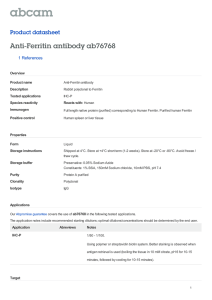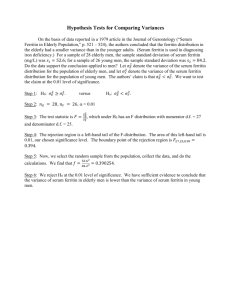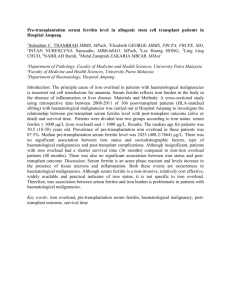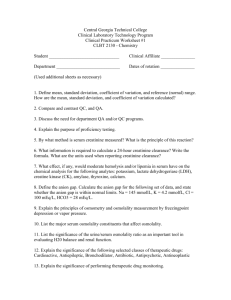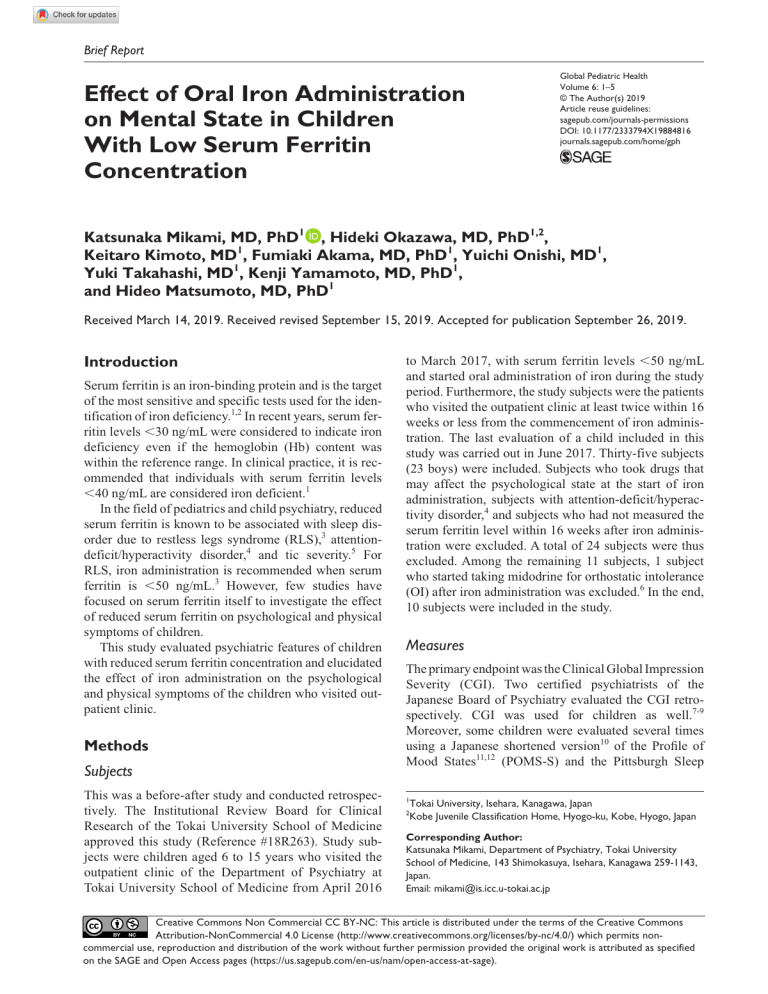
884816 research-article2019 GPHXXX10.1177/2333794X19884816Global Pediatric HealthMikami et al Brief Report Effect of Oral Iron Administration on Mental State in Children With Low Serum Ferritin Concentration Global Pediatric Health Volume 6: 1­–5 © The Author(s) 2019 Article reuse guidelines: sagepub.com/journals-permissions https://doi.org/10.1177/2333794X19884816 DOI: 10.1177/2333794X19884816 journals.sagepub.com/home/gph Katsunaka Mikami, MD, PhD1 , Hideki Okazawa, MD, PhD1,2, Keitaro Kimoto, MD1, Fumiaki Akama, MD, PhD1, Yuichi Onishi, MD1, Yuki Takahashi, MD1, Kenji Yamamoto, MD, PhD1, and Hideo Matsumoto, MD, PhD1 Received March 14, 2019. Received revised September 15, 2019. Accepted for publication September 26, 2019. Introduction Serum ferritin is an iron-binding protein and is the target of the most sensitive and specific tests used for the identification of iron deficiency.1,2 In recent years, serum ferritin levels <30 ng/mL were considered to indicate iron deficiency even if the hemoglobin (Hb) content was within the reference range. In clinical practice, it is recommended that individuals with serum ferritin levels <40 ng/mL are considered iron deficient.1 In the field of pediatrics and child psychiatry, reduced serum ferritin is known to be associated with sleep disorder due to restless legs syndrome (RLS),3 attentiondeficit/hyperactivity disorder,4 and tic severity.5 For RLS, iron administration is recommended when serum ferritin is <50 ng/mL.3 However, few studies have focused on serum ferritin itself to investigate the effect of reduced serum ferritin on psychological and physical symptoms of children. This study evaluated psychiatric features of children with reduced serum ferritin concentration and elucidated the effect of iron administration on the psychological and physical symptoms of the children who visited outpatient clinic. Methods Subjects This was a before-after study and conducted retrospectively. The Institutional Review Board for Clinical Research of the Tokai University School of Medicine approved this study (Reference #18R263). Study subjects were children aged 6 to 15 years who visited the outpatient clinic of the Department of Psychiatry at Tokai University School of Medicine from April 2016 to March 2017, with serum ferritin levels <50 ng/mL and started oral administration of iron during the study period. Furthermore, the study subjects were the patients who visited the outpatient clinic at least twice within 16 weeks or less from the commencement of iron administration. The last evaluation of a child included in this study was carried out in June 2017. Thirty-five subjects (23 boys) were included. Subjects who took drugs that may affect the psychological state at the start of iron administration, subjects with attention-deficit/hyperactivity disorder,4 and subjects who had not measured the serum ferritin level within 16 weeks after iron administration were excluded. A total of 24 subjects were thus excluded. Among the remaining 11 subjects, 1 subject who started taking midodrine for orthostatic intolerance (OI) after iron administration was excluded.6 In the end, 10 subjects were included in the study. Measures The primary endpoint was the Clinical Global Impression Severity (CGI). Two certified psychiatrists of the Japanese Board of Psychiatry evaluated the CGI retrospectively. CGI was used for children as well.7-9 Moreover, some children were evaluated several times using a Japanese shortened version10 of the Profile of Mood States11,12 (POMS-S) and the Pittsburgh Sleep 1 Tokai University, Isehara, Kanagawa, Japan Kobe Juvenile Classification Home, Hyogo-ku, Kobe, Hyogo, Japan 2 Corresponding Author: Katsunaka Mikami, Department of Psychiatry, Tokai University School of Medicine, 143 Shimokasuya, Isehara, Kanagawa 259-1143, Japan. Email: mikami@is.icc.u-tokai.ac.jp Creative Commons Non Commercial CC BY-NC: This article is distributed under the terms of the Creative Commons Attribution-NonCommercial 4.0 License (http://www.creativecommons.org/licenses/by-nc/4.0/) which permits noncommercial use, reproduction and distribution of the work without further permission provided the original work is attributed as specified on the SAGE and Open Access pages (https://us.sagepub.com/en-us/nam/open-access-at-sage). 2 Global Pediatric Health Quality Index13,14 (PSQI) to evaluate the degree of improvement. POMS-S evaluated tension-anxiety (TA), depression-dejection (D), anger-hostility (AH), vigor (V), fatigue (F), and confusion (C). Standardized scores obtained by converting raw scores were used. Score 50 of each subcategory was the average value in general population. The standardized scores were adjusted by age. A conversion chart10 targeting youth aged 19 years or younger was used. Higher scores indicated severer symptoms for all POMS-S subscales except “V.” PSQI was used to assess subjective sleep quality. The cutoff point was 5.5, with higher scores indicating severe symptoms of insomnia. Since only children may have been insufficient to understand those scales, the assessment was conducted through discussion between the child and the parent. Several researches used POMS15-17 or PSQI18,19 for assessment of children. The psychiatric diagnosis was carried out based on Diagnostic and Statistical Manual of Mental Disorders, Fourth Edition, Text Revision. These evaluations within 16 weeks after iron administration were conducted around weeks 6 and 12. One subject evaluated POMS around weeks 10 and 16. Only the data of PSQI were assessed at baseline and 12 weeks. were found in Hb or MCV, whereas significant increases were observed in the levels of serum ferritin (P = .002). Six patients were diagnosed with adjustment disorder, 1 with social anxiety disorder, 1 with general anxiety disorder, 1 with separation anxiety disorder, and 1 with autism spectrum disorder. The number of the subjects with anxiety/tension (POMS-S-TA score was over 50), confusion (POMS-S-C score was over 50), or depression (POMS-S-D score was over 50) was 9, 8, and 7, respectively. Of 10 subjects, CGI was estimated for all the subjects at baseline, week 6, and week 12. POMS-S were administered to 9 subjects at baseline and at week 12, and 8 subjects at week 6. PSQI was assessed for 8 subjects at baseline and at week 12. The results of CGI, POMS-S, and PSQI are shown in the Figure 1. Eight out of 10 subjects took 50 to 100 mg iron orally during the observation period. Nausea was noted as an adverse event in 2 subjects. At week 12 after iron administration, 5 of the 6 subjects who refused to attend school displayed improvement or improvement trends. Four out of 10 subjects were diagnosed with OI at the pediatric department before visiting the department of psychiatry. None of the 4 subjects received drug treatment for OI at the start of iron administration. Statistical Analysis Discussion Continuous variables were presented as means and standard deviation. Categorical variables were compared using Fisher’s exact test. Continuous variables were compared using the Mann-Whitney U test. To identify differences in scores between at baseline and approximate week 6 or week 12, a Wilcoxon’s signed rank test was used. A P value <.05 was defined as significant. IBM SPSS Statistics version 20 for Windows was used for data analysis. This is the first study to show that iron administration to children without anemia and with reduced serum ferritin (<50 ng/mL) improves symptoms such as anxiety, low concentration, depression, fatigability, and/or insomnia, as well as the CGI. Our results also suggest that 6 weeks of iron administration are not sufficient and at least 12 weeks of iron administration are necessary to improve these psychological states and CGI. In this study, the most prevalent physical symptoms due to reduced serum ferritin levels were insomnia and fatigability. Although these symptoms are also observed in RLS,3 no cases with RLS were confirmed in the medical information of our study subjects. However, we cannot rule out the possibility that RLS was missed in some participants of this study. Nevertheless, iron administration should be considered regardless of the presence or absence of RLS when insomnia is noted in subjects with 50 ng/mL or less serum ferritin. Confusion (POMS-S-C) included the element of low concentration. In this study, anxiety/tension, low concentration, and depression were prevalent psychological symptoms of serum ferritin reduction. Iron is not only used for hemoglobin synthesis but also used for the regulation of neurotransmitters such as dopamine and serotonin, and as a cofactor for their production.20,21 These functions may be sufficient to explain the results of this Results The mean age of the 10 study subjects (5 boys) was 11.8 years. A comparison of the 10 study subjects and 25 subjects who were excluded demonstrated no significant differences in age, gender, Hb, mean corpuscular volume (MCV), or serum ferritin (data not shown). Most prevalent physical symptoms were fatigability (10 subjects) and insomnia (either difficulty falling asleep, arousal during sleep, or difficulty awakening in the morning; 9 subjects). None of the 10 study subjects had Hb of <12 g/dL at baseline. At baseline and week 12, the mean Hb was 13.6 g/dL and 13.4 g/dL, the MCV was 86.0 fL and 86.6 fL, and the mean serum ferritin concentration was 25.4 ng/mL and 58.2 ng/mL, respectively. Compared with the baseline, no significant differences 3 Mikami et al Figure 1. The data of approximate 6 weeks (mean 6.7 weeks) and 12 weeks (mean 12.6 weeks) were compared with that of baseline using a Wilcoxon’s signed rank test. The mean number (SD) is shown. As for a Japanese shortened version of the Profile of Mood States (POMS-S) scores, at 6 weeks, only POMS-S-tension-anxiety (TA) score decreased significantly (P = .023). At 12 weeks, all the POMS-S scores except POMS-S-vigor (V) decreased significantly (POMS-STA, P = .020; POMS-S-depression-dejection [D], P = .031; POMS-S-anger-hostility [AH], P = .031; POMS-S-V, P = .258; POMS-S-fatigue [F], P = .008; POMS-S-confusion [C], P = .008). Regarding the Clinical Global Impression Severity (CGI), no significant decrease was observed at week 6, while there was a significant decrease at week 12 (P = .039). A significant decrease of the Pittsburgh Sleep Quality Index (PSQI) score was noted at week 12 (P = .016). study. Furthermore, fatigability and insomnia caused by chronic iron deficiency may have induced a state that is predisposed to anxiety, low concentration, and/or depression. In brief, for children with lower resilience to stress, fatigue, and insomnia caused by chronic iron deficiency may have triggered a decrease in resilience of children, thereby enhancing anxiety, low concentration, and depression. 4 The study has limitations. First, it involves only a small number of subjects. Because professionals in the field of child psychiatry and pediatrics had little awareness of the effects of reduced serum ferritin levels on psychological symptoms, serum ferritin concentration was not measured on most occasions when patients visited the hospital, and it was difficult to retrospectively collect cases. Second, all self-rating scales used in this study were not targeted to children aged 6 to 15 years. In this study, each scale was evaluated through collaboration between the child and the parent, resulting in subjective and objective evaluations. This study suggested that it was necessary to measure the serum ferritin levels of children with insomnia and/ or fatigability who visited the outpatient clinics regardless of their psychiatric diagnoses or gender. Serum ferritin levels are significantly reduced in children and adolescents who visit community mental health clinics.22 In conclusion, iron administration to children with reduced serum ferritin could improve symptoms such as anxiety, low concentration, depression, fatigability, and/ or insomnia, as well as the state of daily activity. Both child psychiatrists and pediatricians should consider administering iron, even if the child does not have anemia, for at least 12 weeks regardless of the psychiatric diagnosis or gender, if the child presents with psychological symptoms, fatigability, and/or insomnia, and has reduced serum ferritin levels. Author Contributions KM: Contributed to conception and design; contributed to acquisition, analysis, and interpretation; drafted manuscript; critically revised manuscript; gave final approval; agrees to be accountable for all aspects of work ensuring integrity and accuracy. HO: Contributed to conception and design; contributed to interpretation; drafted manuscript; critically revised manuscript; gave final approval; agrees to be accountable for all aspects of work ensuring integrity and accuracy. KK: Contributed to conception; contributed to acquisition, analysis, and interpretation; drafted manuscript; critically revised manuscript; gave final approval; agrees to be accountable for all aspects of work ensuring integrity and accuracy. FA: Contributed to conception; contributed to interpretation; drafted manuscript; critically revised manuscript; gave final approval; agrees to be accountable for all aspects of work ensuring integrity and accuracy. YO: Contributed to conception and design; contributed to acquisition and interpretation; drafted manuscript; critically revised manuscript; gave final approval; agrees to be accountable for all aspects of work ensuring integrity and accuracy. YT: Contributed to conception; contributed to interpretation; drafted manuscript; critically revised manuscript; gave final approval; agrees to be accountable for all aspects of work ensuring integrity and accuracy. Global Pediatric Health KY: Contributed to conception; contributed to interpretation; drafted manuscript; critically revised manuscript; gave final approval; agrees to be accountable for all aspects of work ensuring integrity and accuracy. HM: Contributed to conception; contributed to interpretation; drafted manuscript; critically revised manuscript; gave final approval; agrees to be accountable for all aspects of work ensuring integrity and accuracy. Declaration of Conflicting Interests The author(s) declared the following potential conflicts of interest with respect to the research, authorship, and/or publication of this article: Katsunaka Mikami has received research support from Taisho Pharmaceutical, Otsuka Pharmaceutical, Shionogi & Co, Japanese Society for Probiotic Science; honoraria from Otsuka Pharmaceutical, Shionogi & Co, Shire Japan, Eli Lilly and Co, Meiji Holdings Co, Takeda Pharmaceutical; and a consulting fee from Otsuka Pharmaceutical. Keitaro Kimoto received research supports from Otsuka Pharmaceutical, Shionogi & Co, and Taisho Pharmaceutical. Fumiaki Akama has received research support from Otsuka Pharmaceutical and Shionogi & Co; and honoraria from Dainippon Sumitomo Pharma, Pfizer, Shionogi & Co, and Eisai Co. Yuichi Onishi has received research support from Taisho Pharmaceutical and Shionogi & Co; and honoraria from Mylan. Kenji Yamamoto reports grants from Esai Co; grants and personal fees from Otsuka Pharmaceutical; personal fees from Meiji Seika Pharma Co, Sumitomo Dainippon Pharma Co, Pfizer, Mitsubishi Tanabe Pharma Corporation, TEIJIN Pharma Limited, Eli Lilly and Co, Yoshitomiyakuhin Corporation, Janssen Pharmaceutical, Merck Sharp & Dohme, GlaxoSmithKline, EPS Holdings, Daiichi Sankyo Co; and grants from Health and Labor Sciences Research outside the submitted work. Hideo Matsumoto received research support from Dainippon Sumitomo, Otsuka Pharmaceutical, Shionogi & Co, KOIKE-YA Inc, Mental Clinic Yokohama Minatomirai, Kishi Byoin, Soushu Hospital, Kouzu Hospital, Tanzawa Hospital, Aikou Hospital, and Keyaki-no-mori Hospital; and honoraria from Eli Lilly and Co, Novartis Pharma, Yoshitomiyakuhin Corporation, GlaxoSmithKline, Dainippon Sumitomo, Pfizer, Meiji Seika Pharma, Otsuka Pharmaceutical, Janssen Pharmaceutical, Eisai Co, Shionogi & Co, Astellas Pharma, MSD, and Mitsubishi Tanabe Pharma Corporation. Hideki Okazawa and Yuki Takahashi have no conflicts of interest to disclose. Funding The author(s) received no financial support for the research, authorship, and/or publication of this article. ORCID iD Katsunaka Mikami https://orcid.org/0000-0002-8818-4945 References 1. Knovich MA, Storey JA, Coffman LG, Torti SV, Torti FM. Ferritin for the clinician. Blood Rev. 2009;23:95-104. Mikami et al 2. Camaschella C. Iron-deficiency anemia. N Engl J Med. 2015;373:485-486. 3. Dosman C, Witmans M, Zwaigenbaum L. Iron’s role in paediatric restless legs syndrome—a review. Paediatr Child Health. 2012;17:193-197. 4. Tseng PT, Cheng YS, Yen CF, et al. Peripheral iron levels in children with attention-deficit hyperactivity disorder: a systematic review and meta-analysis. Sci Rep. 2018;8: 788. 5. Ghosh D, Burkman E. Relationship of serum ferritin level and tic severity in children with Tourette syndrome. Childs Nerv Syst. 2017;33:1373-1378. 6. Stewart JM, Boris JR, Chelimsky G, et al. Pediatric disorders of orthostatic intolerance. Pediatrics. 2018;141: e20171673. 7. Bearss K, Johnson C, Smith T, et al. Effect of parent training vs parent education on behavioral problems in children with autism spectrum disorder: a randomized clinical trial. JAMA. 2015;313:1524-1533. 8. Ichikawa H, Mikami K, Okada T, et al. Aripiprazole in the treatment of irritability in children and adolescents with autism spectrum disorder in Japan: a randomized, doubleblind, placebo-controlled study. Child Psychiatry Hum Dev. 2017;48:796-806. 9. Upadhyaya HP, Arnold LM, Alaka K, Qiao M, Williams D, Mehta R. Efficacy and safety of duloxetine versus placebo in adolescents with juvenile fibromyalgia: results from a randomized controlled trial. Pediatr Rheumatol Online J. 2019;17:27. 10. Yokoyama K. POMS tansyuku-ban: tebiki to jirei-kaisetsu [Profile of Mood States–Brief Japanese Version: Manual and Commentary on Cases]. Tokyo, Japan: Kaneko Shobo; 2005. 11. McNair D, Loor M, Droppleman LF. EITS Manual for the Profile of Mood States. San Diego, CA: Educational and Industrial Testing Service; 1971. 12. Shacham S. A shortened version of the Profile of Mood States. J Pers Assess. 1983;47:305-306. 5 13. Buysse DJ, Reynolds CF 3rd, Monk TH, Berman SR, Kupfer DJ. The Pittsburgh Sleep Quality Index: a new instrument for psychiatric practice and research. Psychiatry Res. 1989;28:193-213. 14. Doi Y, Minowa M, Uchiyama M, et al. Psychometric assessment of subjective sleep quality using the Japanese version of the Pittsburgh Sleep Quality Index (PSQI-J) in psychiatric disordered and control subjects. Psychiatry Res. 2000;97:165-172. 15. Campbell M, Adams PB, Small AM, et al. Lithium in hospitalized aggressive children with conduct disorder: a double-blind and placebo-controlled study. J Am Acad Child Adolesc Psychiatry. 1995;34:445-453. 16. Martin CA, Guenthner G, Bingcang C, Rayens MK, Kelly TH. Measurement of the subjective effects of methylphenidate in 11- to 15-year-old children with attention-deficit/ hyperactivity disorder. J Child Adolesc Psychopharmacol. 2007;17:63-73. 17. Lambrechts DA, Bovens MJ, de la Parra NM, Hendriksen JG, Aldenkamp AP, Majoie MJ. Ketogenic diet effects on cognition, mood, and psychosocial adjustment in children. Acta Neurol Scand. 2013;127:103-108. 18. Yuksel H, Sogut A, Yilmaz O, Demet M, Ergin D, Kirmaz C. Evaluation of sleep quality and anxiety-depression parameters in asthmatic children and their mothers. Respir Med. 2007;101:2550-2554. 19. Erwin AM, Bashore L. Subjective sleep measures in children: self-report. Front Pediatr. 2017;5:22. 20. Yager JY, Hartfield DS. Neurologic manifestations of iron deficiency in childhood. Pediatr Neurology. 2002;27:85-92. 21. Kaushik P, Gorin F, Vali S. Dynamics of tyrosine hydroxylase mediated regulation of dopamine synthesis. J Comput Neurosci. 2007;22:147-160. 22. Gottfried RJ, Gerring JP, Machell K, Yenokyan G, Riddle MA. The iron status of children and youth in a community mental health clinic is lower than that of a national sample. J Child Adolesc Psychopharmacol. 2013;23:91-100.
